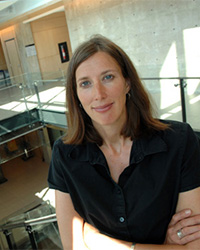Dalhousie has been named a leader in two key categories in a new sustainability index that tracks the top-performing universities and colleges participating in the Sustainability Tracking Assessment Rating System (STARS).
Dal tied for top spot with a number of other institutions in "Coordination & Planning" and placed fifth in "Transportation" in the 2015 Sustainable Campus Index, which highlights best-in-class leaders in 17 different areas measured by STARS.
 “Only a handful of Canadian universities were identified as top achievers,” says Rochelle Owen, director of Dalhousie’s Office of Sustainability.
“Only a handful of Canadian universities were identified as top achievers,” says Rochelle Owen, director of Dalhousie’s Office of Sustainability.
The Coordination and Planning subcategory recognizes institutions that show dedication to sustainability through coordination and illustrate a commitment to developing plans to achieve progress in sustainability. Dal earned a perfect grade of 100 percent in the area along with 43 other institutions.
Dal ranked fifth overall, just after Stanford University, in the Transportation subcategory, which highlights schools that have excelled in moving toward a more climate-friendly transportation system through minimizing greenhouse gas emissions and promoting human health.
"Dalhousie's participation in STARS and strong performance in the areas of coordination and transportation demonstrate significant leadership and commitment to advancing sustainability," says Meghan Fay Zahniser, AASHE's executive director.
Going “gold”
In early 2015, Dal earned an overall gold designation from the Association for the Advancement of Sustainability in Higher Education (AASHE) — the group that administers the STARS program. AASHE's Sustainable Campus Index provides an additional level of recognition to gold recipients that go above and beyond.
Dal has undertaken a number of recent initiatives on both the planning and transportation fronts when it comes to sustainability, says Owen.
Under Owen's direction, Dal has implemented a number of comprehensive university-wide planning documents related to sustainability, including a detailed climate-change plan.
"We have shown up in international research as one of the few universities that has climate-change mitigation and adaptation goals," she says.
Students have teamed up with former Environment Canada staff to work on detailed climate modelling for the Agricultural Campus in Truro.
"Each plan takes two to three years, but I feel pretty confident that at the end they are pretty robust," says Owen.
Making connections
On the transportation front, Dal scored extra points for putting together an annual commuter survey that provides a glimpse into the different modes of transportation used by members of the university community.
Owen's office has teamed up with Professor Ahsan Habib's DalTRAC research team in the School of Planning to analyze the data, which is then used to create new programs and modify existing ones such as the employee bus pass and cycling infrastructure. Other external partners have used this data for research and planning efforts.
“Rather than just hypothesizing what we think our employees or students are feeling or experiencing, we use the data sets to bring that forward for policy decisions that affect the university that are controlled by other entities,” explains Owen.
Owen says Dal’s efforts to engage the broader community are another factor in why it’s being recognized. For example, Dal is a founding member of the Institutional Transportation Demand Management Committee that includes local hospitals, Saint Mary’s University and city officials, and builds on information sharing gained in town hall meetings held at Dal.
Owen, who was recognized Friday by the City of Halifax, the Clean Foundation and the Ecology Action Centre for her work as a leader in climate change, says Dal’s progress on the sustainability front has also been helped by the work being done by faculty, students and staff.
“Every faculty has professors and students working on some aspect of climate change and energy research,” says Owen. “And there is curriculum related to that.”

